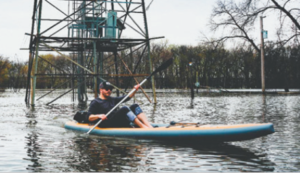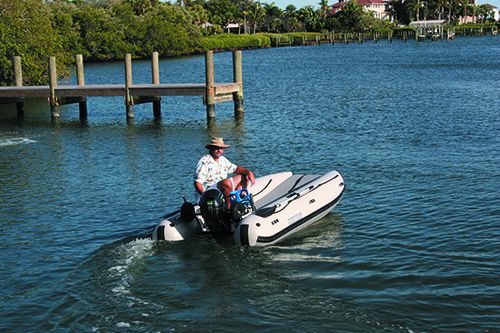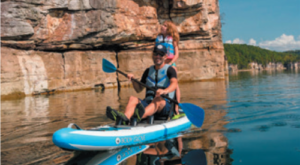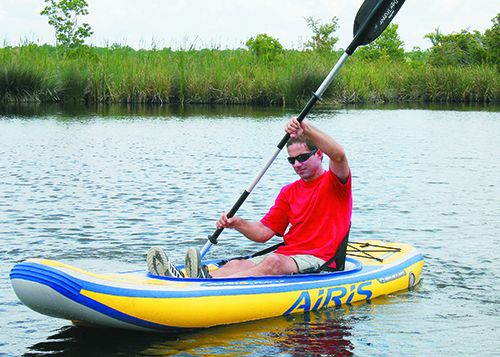Our previous favorite kayak in this category was the Walker Bay Airis, which we reviewed in two different evolutions (PS July 2008 and October 2017). The boat is light (less than 20 pounds for the bare boat), can pack into a backpack, and is stiff enough for open water paddling. Like any sit-on-top kayak they are easy to board from the water, but not as fast to paddle as a rigid, sit-in kayak. But the inflatable feature makes them practical on the smallest boat. Lamentably, the Airis was discontinued in 2018.
We’ve found two new candidates that tick many of the same boxes. Both are constructed from PVC fabric utilizing drop-stitch construction to create rigid structures. Like the Airis, these can be used as stand-up paddleboards (SUP) when fully inflated. The valves are the same as those used in quality inflatable dinghies.
Although we have not lived with either of these long enough to be certain, durability should be similar to PVC inflatable dinghies. We’ve paddled our Airis Sport every week or two for 3 years. We’ve left it in the sun for months, bumped into a few rocks, and are thus convinced that the basic material of construction is sound and suitable for the purpose.
Drop-stitch construction, in which a webPADDLE NORTH of threads connects the outer skins, is what gives inflatables their impressive rigidity. The inflation pressure is greater—10-12 psi vs. 3-4 psi for a typical . This is what allows for the miraculously rigid structure, with no more pressure than the typical inflatable tender. Because there are so many threads, the stress is evenly distributed and redundancy is inherent.
These aren’t your blow up pool toys, and although we don’t recommend it, we’ve run easy white water in these as a test. With the right thigh braces they aren’t half bad, fully stiff enough to transfer paddling power, and light enough to respond.
Both have a rated capacity of 350 pounds, and we have tested them with paddlers up to 190 pounds, and with a pair, just for fun, up to 300 pounds. Unsurprisingly, we’d expect stability to suffer for any paddler who weighs over about 225 pounds.
Like the Airis, both have rear skegs to provide tracking. It works when paddling in a straight line, but if you want to cut a sharp turn—for example in a marina—backing works better, since the pivot point is near the stern. Like the Airis, both have the greatest width just behind the cockpit. This increases speed and maintains stability, without making the boat too wide for efficient paddling, a common shortcoming of inflatable kayaks and sit-on-top kayaks.
Both come with four-piece break-down paddles. We preferred the two-piece Walker Bay paddle for its exceptional stiffness and durability. We’ve banged it against rocks for days paddling white water. But the four-piece paddles seem well made and pack smaller.
Both boats come with efficient manual inflation pumps. Because of the relatively low volume, high-pressure kayaks take only a few minutes to inflate. Once you have done it a couple of times, you’ll need only about five minutes to get on the water.
Both boats lack the bow and stern handles of the Airis, which are handy both for handling and for lashing the kayak on deck. Walker Bay makes dinghies and recognizes this practicality.
Although of limited value to the cruiser, the included backpack can open the option of a hike to a secluded patch of water.
KAYAKS FOR CRUISING SAILBOATS
| MAKER | MODEL/TYPE | MATERIAL | LENGTH | BEAM (INCHES) | WEIGHT | FLOOR HEIGHT | STABILITY | COMFORT* | MAX. PSI (FLOOR) | PRICE |
|---|---|---|---|---|---|---|---|---|---|---|
| PERCEPTION | Impulse/ Sit in | Polyethylene | 10 ft. | 29.5 in. | 44 lbs. | 2 in. | 4 | 4 | - | 450 |
| WILDRENESS STSTEMS | Aspire 105/ Sit in | Polyethylene | 10.5 ft. | 29 in. | 46 lbs. | 2 in. | 4 | 4.6 | - | 780 |
| OCEAN KAYAK | Frenzy/ Sit on top | Polyethylene | 9 ft. | 31 in. | 44 lbs. | 3 in. | 4 | 3.3 | - | 450 |
| HOBIE | Lanai DLX/ Sit in | Polyethylene | 9 ft. | 30 in. | 48.5 lbs. | 3 in. | 4 | 3 | - | 830 |
| INFLATABLES | ||||||||||
| WALKER BAY | Airis Play/ Sit on top | PVC | 8.5 ft. | 31.5 in. | 18 lbs. | 3 in. | 4 | 2.3 | 6.5 psi | 699 |
| WALKER BAY | Airis Sport/ Sit on top | PVC | 10.8 ft. | 31 in. | 20 lbs. | 3 in. | 4 | 2.3 | 6.5 psi | 789 |
| STEARNS | Sea Eagle 330/ Sit-in | PVC | 11.2 ft. | 26 in. | 26 lbs. | 2 in. | 4 | 1 | 1.1 psi | 250 |
| ADVANCED ELEMENTS | Sport Katak/ Sit in | PVC | 10.5 ft. | 32 in. | 26 lbs. | 2 in. | 4 | 1 | 2 psi | 399 |
| PADDLE NORTH | Karve | PVC | 12 ft. | 33 in. | 21 lbs. | 3 in. | 3 | 2 | 10-12 psi | 900 |
| BODY GROVE | Glide | PVC | 11 ft. | 32 in. | 19 lbs. | 5.5 in. | 4 | 3 | 10-12 psi | 500 |
| PEDAL POWER | ||||||||||
| HOBIE | Sport/ Sit on top | Polyethylene | 9.6 ft. | 29.5 in. | 76 lbs. | 3 in. | 3 | 4 | - | 2300 |
| HOBIE | Outback/ Sit on top | Polyethylene | 12.1 ft. | 33 in. | 97 lbs. | 8 in. | 3 | 4 | - | 2500 |
| PERCEPTION | Pescador Pilot/ Sit in | Polyethylene | 12.4 ft. | 36 in. | 95 lbs. | 4 in. | 3 | 4 | - | 1800 |

Paddle North Karve
Like the Airis, this inflatable features a cut-out cockpit area with a separate floor, providing a place to put a few things, a lower center of gravity, and enough drainage to prevent a wet bottom, at least in sheltered waters.
Our test paddle was on a nasty, rainy day, and the sharply pointed bow and V-shaped entry of the Karve showed its value, cutting through the chop better than the blunt bow of the Airis and pounding less than the flat-bottomed Glide. We wish it had thigh strap braces, like the Airis. It has a strap you can tuck your feet under, but nothing to provide good solid side bracing.
Bottom line: Best Choice. This is a true contender for cruisers.

Our search for a compact inflatable dinghy led us to the Takacat LX, a line of inflatable catamarans developed in New Zealand. Established in 2007, Takacat (www.takacat.com) has grown a steady following abroad and distribution in North America is expanding. Hulls are built in China, but the company is looking into U.S. production.
We spent two afternoons with Luis Sanchez, of Sky Blue Adventures (www.skyblueadventures.com) testing the Takacat 340 ($2,000, 11’ LOA, 5’5” beam, 19” tube diameter, 1,135 lb. capacity). The 340 is the middle boat in the five-boat series, ranging from 8 to 14 feet. The two larger sizes, the 380 and 420, divide each hull into two air chambers, but otherwise the construction details are consistent throughout the XL line. Thermo-welded PVC hulls are available in several colors. Glued hypalon hulls are an option.
We tested the boat with two motors—a 9.9 horsepower LEHR propane outboard (about 15 lbs. lighter than a conventional gas 9.9 hp), and the electric ePropulsion Spirit 1.0, (1,276 watt-hours, 3 hp equivalent). Made in China, the $1,700 ePropulsion competes with the well-established Torqeedo (see “New Options in Small Outboards,” PS January 2016).
The boat’s compactness deflated is impressive. The 79-pound boat splits into two bags: hulls (48 pounds, 47” x 14” x 14”); and transom/floor (31 pounds, 35.5” x 14” x 10”). Assembly takes about 10 minutes with a good pump that inflates to at least 10 psi (the rated floor pressure). The hull and deck sections connect with multiple webbing straps and an ingenious “open” transom that also helps spread davit loads.
The conspicuous open bow and stern of the Takacat design allows for flatter, more expansive, and more stable platform than any comparable inflatable we’ve tested. Boarding from water or shore is easier, but what about water ingress? Crossing big boat wakes on the ICW, we shipped no waves. The maker points to its long use its popularity among rescue organizations in New Zealand as proof of its seakeeping ability.
Under the ePropulsion motor, we hummed quietly along at 5 mph with two people (~ 400 pounds). Prop cavitation interrupted the Lehr test, but we were later able to get it to cruise on plane at about 12 knots. According to Sanchez, an anti-cavitation plate (sold separately) solves the problem.
Bottom line: The Takacat fits a unique niche in the dinghy market. Snorkelers, sight fisherman (especially fly fishermen), and cruisers with limited storage space would all benefit from including the Takacat XL line in their list of options.
Body Glove Glide
This is basically a paddleboard adapted to kayaking by providing clip points for a seat back and for foot braces. Because you sit on top of the board, it feels like, well, you are sitting on top of the paddleboard—rather than “in” a kayak.
The foot braces keep your heels from sliding and help avoid the discomfort of sitting with your legs straight out, but they don’t provide lateral bracing.
On the other hand, the Body Glove’s hull makes it a better SUP. If you are looking for an SUP, that can serve as a dinghy in a pinch, this split personality could be an excellent option. If you get tired of standing, or the water becomes too rough for your skill set; just sit down and crank your way back to the mother ship.
Bottom line: This Budget Buy is an excellent value in a kayak/SUP combination.

Conclusions
Your best choice will depend on your expectations. If you glue on a pair of D-rings and add thigh straps, the Karve becomes a very able paddler. The Glide is an excellent choice if you’d like to have an SUP, too. Both store in a large backpack and set up in minutes. Both provide capable warm weather transport for a small sailboat. When our Airis Sport eventually dies we’ll be looking closely at these.



































An interesting new comer in the space of compact kayaks is a start up out of Connecticut called Pakayak. They make a 14′ rigid sea kayak that breaks down into 6 pieces that nest like Russia nesting dolls – packed size is 3.5′ x 2′ x 1.3′. Covid has slowed delivery so I’m still waiting on mine… but I’m excited about having it aboard my sailboat.
Thanks very much for this update. I’ve liked the Sea Eagle Explorer inflatable kayaks very much. They are much more rugged and durable than their lighter model. I’ve had two Sea Eagle 11 kayaks over the past 25 years and have used them from the Florida Keys to Cape Cod. I recommend that you include them. Their model with higher pressure floor is an improvement over their previous design.
Jess Gregory
Gainesville, FL
I’ll vouch for the Sea Eagle line. My 385FT has been my sailboat tender for many years, has taken me on remote river trips here in Alaska and fishing in the surf in Mexico. And I have a KayakSailor sailing rig for it. The FT (Fast Track) has an inflatable partial keel which makes it track when paddling like on rails. I also have an Airis, which is lighter and easier to get on and off the boat, but has very low freeboard and no self bailing ports so it gets wet inside if there is much of a chop. Several other companies make drop stitch high pressure floor sit-inside inflatable kayaks of varying quality levels and some appear to be excellent. When (if) my Sea Eagle ever wears out I’m going to consider the Aquaglide Chelan line.
I’ve enoyed a Aire Super Lynx inflateable kayak for years. Terrific product from a great company. Stows easily on our Jeanneau 42DS. It is 14 ft and handles 2 people w/ gear. Almost impossible to tip over. Highly recommend.
We had a guest at our house this summer and she had a Tucktec fold, roll up kayak. In its collapsed form it is about 1.5′ diameter x 4′ long and takes 3 minutes to set up. She was out on the lake in 20+ mph winds and white caps and said she felt stable and it tracked ok it took “a while” to get back paddling into the wind. The price was around $300.
My wife has had the Paddle North kayak for three years and we are 100% satisfied. We saw these guys up at the Milwaukee boat show one winter and were really impressed. They seemed a little bit like a shoestring operation at the time, but they were really good to work with and the product is well-designed and high-quality.
The package isn’t light, but it’s light enough that she can get it in and out of her car and onto the boat. The case has wheels and a handle on the bag so it rolls easily.
When inflated it is very stable and comfortable to paddle. She primarily uses it for harbor recreation and fitness paddling. One item of note – hers is designed to also be used as SUP, and the included paddle is designed to work both ways. The article implies that it isn’t suited for that, but ours works well as a SUP.
My only complaint is that my wife left the bag sitting on our white boat cushions and the black dye from the bag leached through. Fortunately, we were able to clean it, but we are careful about that now. No issues with the white fiberglass, but if you put the bag on a light-colored seat, put a towel under it.
After trying ours, a friend bought the 2-seater as a college graduation present for his son. He has been very happy as well.
Overall, highly recommended.
Thanks for the great article.
How does this one glue D-rings to such a craft? How strong is the result?